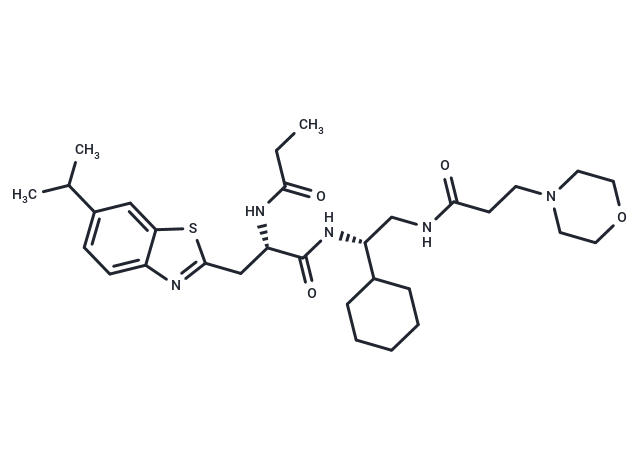Shopping Cart
- Remove All
 Your shopping cart is currently empty
Your shopping cart is currently empty

DI-591 is an effective, high-affinity and cell-permeability inhibitor for DCN1-UBC12 interaction. DI-591 binds to DCN1 and DCN2 with Ki values of 12 and nM and 10.4 nM, respectively, and has no obvious binding to DCN3, DCN4 and DCN5 proteins.

| Pack Size | Price | Availability | Quantity |
|---|---|---|---|
| 25 mg | $1,420 | 8-10 weeks | |
| 50 mg | $1,850 | 8-10 weeks | |
| 100 mg | $2,970 | 8-10 weeks |
| Description | DI-591 is an effective, high-affinity and cell-permeability inhibitor for DCN1-UBC12 interaction. DI-591 binds to DCN1 and DCN2 with Ki values of 12 and nM and 10.4 nM, respectively, and has no obvious binding to DCN3, DCN4 and DCN5 proteins. |
| In vitro | DI-591 binds to DCN1 and DCN2 with Ki values of 12 nM and 10.4 nM, respectively, and has no obvious binding to DCN3, DCN4 and DCN5 proteins. Therefore, DI-591 has a high binding affinity for recombinant human DCN1 and DCN2 proteins, and its selectivity is more than 1000 times that of recombinant human DCN3-5 protein [1]. DI-591 (0-10μM; 1 hour; KYSE70 cells) binds to the DCN1 and DCN2 proteins of the cells and disrupts the binding of the DCN1 and UBC12 proteins. DI-591 (10 μM; 24 hours; THLE2 cells) treatment can strongly increase the mRNA levels of NQO1 and HO1, resulting in the up-regulation of HO1 protein in the cells. It is worth noting that DI-591 has no effect on the mRNA level of NRF2. DI-591's selective inhibition of cullin 3's dienylation leads to the accumulation of NRF2 protein and its transcriptional activation. Knockdown experiments show that DCN1, but not DCN2, plays a key role in the regulation of dimerization of cullin 3 but not other cullins. DI-591 is an excellent probe compound for studying the role of cullin 3 CRL (Cullin-RING E3 ubiquitin ligase) in biological processes and human diseases. |
| Molecular Weight | 585.8 |
| Formula | C31H47N5O4S |
| Cas No. | 2245887-38-9 |
| Relative Density. | 1.169 g/cm3 (Predicted) |
| Storage | Powder: -20°C for 3 years | In solvent: -80°C for 1 year | Shipping with blue ice. |

Copyright © 2015-2024 TargetMol Chemicals Inc. All Rights Reserved.